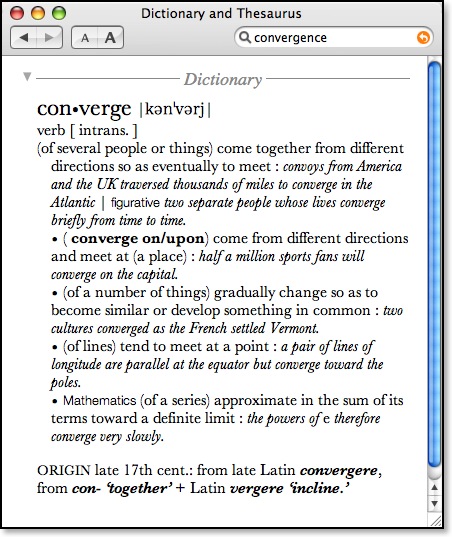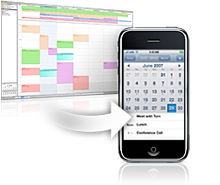iPhone = Convergence
07/10/2007 00:52 Filed in: Technology
In 2003, I had three electronic devices (not counting my laptop) I used regularly and carried with me most places: a Palm Tungsten T, my Motorola Timeport cellphone, and a 20GB (second generation) iPod. Then in October of that year, I obtained the newly released Treo 600 which combined the cellphone and Palm functions. The number of devices I carried were down to two. I remember reflecting at the time that if only I could combine something like the Treo with the functionality of the iPod, I'd be set.
I realize, of course, that to some such gadgets seem unnecessary, but they've become extremely integrated into my life. Let me explain. A little more than a decade ago, I carried a physical daytimer. It was convenient enough for the calendar and address book, but for anything else I had to remember where I had written it. Then in 1997, I bought a Palm Professional which appealed to my proclivity to all things electronic and computerized. Truth be told, there's something I miss about writing appointments with a physical pen or pencil onto an actual page made from wood pulp. Nevertheless, the Palm was most practical. It went into my pocket. I could run searches for information without having to worry about where I had written it. It wasn't something extra to carry with the stack of books that often seem to follow me around wherever I go.
[Sidenote: For those curious, since 1997 I carried in this order a PalmPilot Professional (came with 1 MB of memory but I upgraded it to a whopping 2 MB), Palm IIIe, Palm Vx, Palm Tungsten T, and finally a Palm Treo 600. Of those devices, for purely Palm-based features, the Palm Vx was probably my favorite of all. It was slender, sleek and had a crisp monochrome screen that I felt was never equaled in the color screens of the Tungsten or Treo models that I used. Oh, and I also briefly carried a Compaq iPaq 3850 in early 2002. This PocketPC device was certainly more sophisticated that a Palm PDA, and the promise of it appealed to me; but in the end, I found it to be buggy and needing regular (as in at least daily) reboots to function normally. My final straw was calling tech support about its unreliability, asking why I had to restart it so much, only to have the tech from Compaq say, "What do you expect? It's Windows!"]
As for the iPod, you may be saying to yourself, "I have trouble imagining Rick with headphones on, psychedelically bebopping around like one of those iPod commercials." Well, no, you won't see me doing that. In fact, you'd rarely see me with an iPod although I carried it with me everyday. Generally, I only used it during my commute, which can sometimes last up to an hour. Yes, I do have music on my iPod, but I admit that I don't listen to it that often. My iPod use is mainly geared around listening to content such as lectures, the Mars Hill Audio Journal, audio books, or even audio Bibles (lately I've been listening through the entire TNIV).
And regarding the cell phone aspect, a number of years ago, when we first moved to Simpsonville, Kathy and I opted not to carry local telephone service. Why did we really need to? Couldn't we simply use a cell phone for everything? Is there ever really any need for a landline anymore? So we each have our own cell phones and we haven't missed the $30 or so dollars we used to send to the phone company each month.

First of all, after a week of use and after experiencing the activation woes I wrote about (see here and here), I can say overall that I'm very pleased with the iPhone. Yes, there are a few features it's lacking, which I'll mention below, but overall, it lives up to its promise. Plus, the key to the iPhone is software and currently it's listed at version 1.0. I fully expect that the rough spots and the gaps in the iPhone's applications will be worked out with software updates in the weeks to come. So while, I'm missing some functionality here or there--some of which I was even used to on my Treo--I'm not really concerned.
In my opinion, when timelines are drawn twenty years from now on the the history of mobile phones and the like, the iPhone will have a prominent place along the line. One could easily point out where another PDA or cell phone does many of the same things the iPhone does, but it's the ease of use and the intuitive interface that's key for the iPhone. Email is easy and works as it should. And internet browsing is not an exercise in frustration as it was on my Treo. On the Treo, invariably, the internet's memory cache would get full and I would have to go in and clear it out. Graphics would take so long to load that I completely turned them off so that I simply had little squares with graphical symbols. Plus, it was invariably difficult to maneuver around a webpage on my Treo because it would convert multiple columns to one column. With the iPhone, a webpage renders correctly (except for Flash, but they're working on that) and you can resize it as you need. Double-tapping on a block of text zooms in wonderfully. The internet is actually usable on this phone, and because the screen's resolution is much higher than a typical computer monitor, even the smallest text is quite readable.
A number of folks have complained about AT&T's Edge data network, specifically in regard to speed. However, when the iPhone sense a wifi internet connection, it immediately switches over to that which is faster than any data network anyway. And maybe Edge is slow to some, but I can tell you it's certainly faster than whatever I was using from Sprint on my Treo 600.
I'm so pleased with the email and internet capabilities of the iPhone that it enables even another level of convergence for me. Often, in making a daytrip somewhere, I'll carry my MacBook simply so that I can check email once or twice while I'm away. The iPhone's capabilities are so extensive, however, that I think I could get by for significant amounts of time simply with it alone. Therefore, on short trips I can now leave my laptop at home and simply carry the iPhone. Traveling light is always a plus.
All the concerns over the iPhone's virtual keyboard are mostly gone by now for those who have spent anytime with it. Mistakes are usually corrected with a tap of the virtual space bar if I'm paying attention and willing to trust the iPhone's own "intuition." I think for heavy editing, I might still like an external keyboard. I admit that I haven't used one of these since I had the foldout keyboard for my Palm IIIe (again, it was just something extra to carry), but such a keyboard would be useful with the iPhone, and it could connect via the iPhone's built-in bluetooth, so I hope third parties are already working on something like this.
One of my early concerns for the iPhone was the relatively small flash drive (8 gb). Only recently have I actually filled up the space on my 20gb iPod purchased back in 2002 (this is a pre-photo, pre-video, old-school monochrome iPod). At that point, I began unchecking a few of the unabridged books I have that take up so much space. But the iPhone encourages a different approach. The idea is not to carry everything with you, but just what you need between syncs. And really, this makes sense. I mean if I listened to everything in my iTunes library, I would have to listen for over three weeks with no sleep. I realize now that it's really unnecessary to carry all that stuff with me. The key is to create albums in iTunes so that you can simply select those and sync over what you think you'll need for the time being.
And that's the other thing about the iPhone. I know folks who have so-called smart phones that never sync them regularly. The iPhone seems to drive the user to sync on a regular basis, to update the content for the next day or two's use.
Having said all that, not everything is rosy. Apple's restrictive policy toward 3rd party apps is a real pain. Two applications I miss from my Palm Treo are Pocket Quicken and Olive Tree's Bible Reader. I kept Pocket Quicken synced regularly with Quicken on my desktop Mac and used the mobile version as a check registry when away from home. And although I usually have access to a Bible with me (or Accordance on my MacBook), there were quite a few times that the Bible Reader on my Treo came in quite handy. On the Treo I carried the Greek NT and the NASB with Greek and Hebrew dictionaries. The only third party apps available for the iPhone have to be created using Web 2.0, so I don't expect anything to reach the sophistication of Pocket Quicken. And so far, I've only come across one Bible program for the iPhone (which I'll review in a separate post), but it's KJV only in addition to Mormon scriptures which are, naturally, of no interest to me. I would really like to see someone create an iPhone interface for something like Bible Gateway.
And there are a few basic missing features on the iPhone. For instance today, Kathy emailed me asking for the address of a family member. I had that information in the contacts on my iPhone, but currently, the device does not allow for selecting text and copy and paste. So while I could look up the information, I couldn't copy and paste it into the iPhone's email program. I still had to retype it. This certainly seems like a step backwards. Didn't the original 1984 Mac have copy and paste?

But I'm riding on the assumption that these kinds of issues are minor inconveniences that are inherent to a version 1.0 of the iPhone's software. I'm confident they will be address and hopefully very soon.

However, on a negative note, those "fewest dropped calls" commercials on television are starting to seem a bit disingenuous. Granted my experience is only anecdotal, but I promise you that I've had more dropped calls in the last week with AT&T than I ever did in seven years with Sprint. It's very annoying.
Overall, I highly recommend the iPhone. Yes, the price is a bit steep. But if you can use the features and if it brings convergence to some of the devices you carry, you may agree with me that the iPhone is worth every penny.










